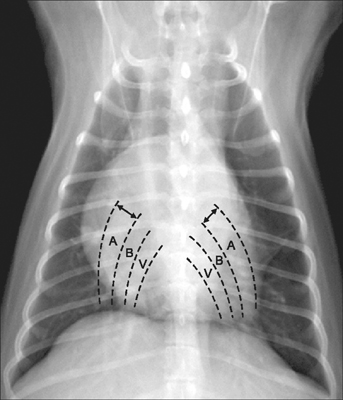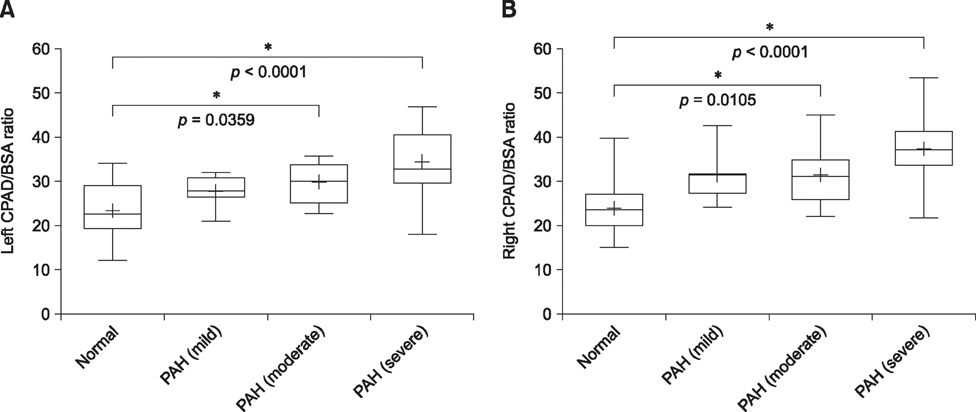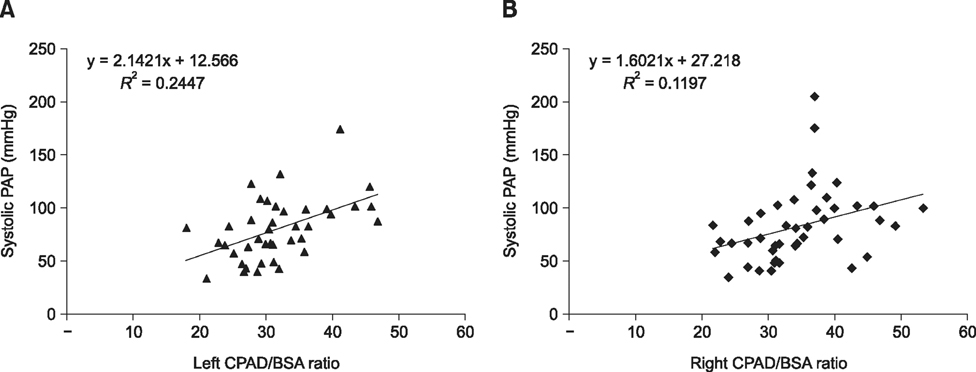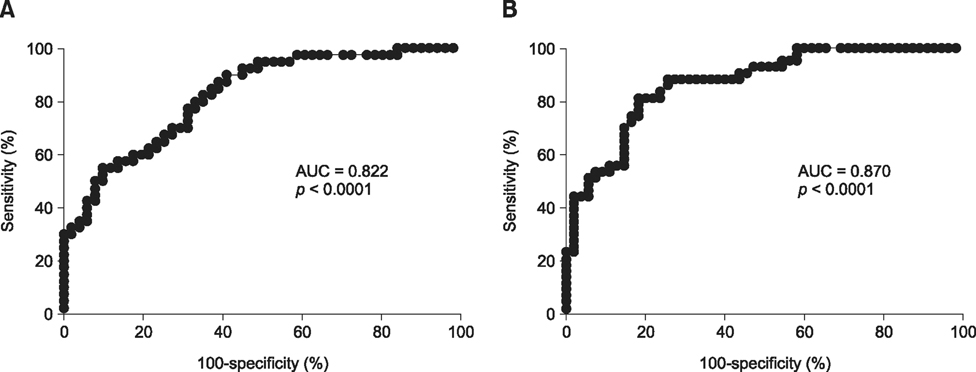J Vet Sci.
2016 Jun;17(2):243-251. 10.4142/jvs.2016.17.2.243.
Correlation between caudal pulmonary artery diameter to body surface area ratio and echocardiography-estimated systolic pulmonary arterial pressure in dogs
- Affiliations
-
- 1Section of Medical Imaging, Veterinary Medical Center, College of Veterinary Medicine, Chungbuk National University, Cheongju 28644, Korea. dwchang@cbnu.ac.kr
- 2Laboratory of Veterinary Internal Medicine, Veterinary Medical Center, College of Veterinary Medicine, Chungbuk National University, Cheongju 28644, Korea.
- 3Veterinary Medical Imaging, College of Veterinary Medicine, Chonnam National University, Gwangju 61186, Korea.
- KMID: 2413174
- DOI: http://doi.org/10.4142/jvs.2016.17.2.243
Abstract
- Caudal pulmonary artery diameter (CPAD) to body surface area (BSA) ratios were measured in ventrodorsal thoracic radiographs to assess the correlation between CPAD to BSA ratios and systolic pulmonary arterial pressure (PAP) in dogs. Thoracic radiographs of 44 dogs with systolic pulmonary arterial hypertension (PAH) and 55 normal dogs were evaluated. Systolic PAP was estimated by Doppler echocardiography. CPADs were measured at their largest point at the level of tracheal bifurcation on ventrodorsal radiographs. Both right and left CPAD to BSA ratios were significantly higher in the PAH group than in the normal group (p < 0.0001). Linear regression analysis showed positive associations between PAP and right and left CPAD to BSA ratio (right, p = 0.0230; left, p = 0.0012). The receiver operating characteristic curve analysis revealed that the CPAD to BSA ratio had moderate diagnostic accuracy for detecting PAH. The operating point, sensitivity, specificity, and area under the curve were 28.35, 81.40%, 81.82%, and 0.870; respectively, for the right side and 26.92, 80.00%, 66.67%, and 0.822, respectively, for the left. The significant correlation of CPAD to BSA ratio with echocardiography-estimated systolic PAP supports its use in identifying PAH on survey thoracic radiographs in dogs.
MeSH Terms
Figure
Reference
-
1. Bach JF, Rozanski EA, MacGregor J, Betkowski JM, Rush JE. Retrospective evaluation of sildenafil citrate as a therapy for pulmonary hypertension in dogs. J Vet Intern Med. 2006; 20:1132–1135.
Article2. Bezuidenhout AJ. The heart and arteries. In : Evans HE, de Lahunta A, editors. Miller's Anatomy of the Dog. 4th ed. Philadelphia: Elsevier Saunders;2013. p. 441.3. Brown AJ, Davison E, Sleeper MM. Clinical efficacy of sildenafil in treatment of pulmonary arterial hypertension in dogs. J Vet Intern Med. 2010; 24:850–854.
Article4. Brown DJ, Rush JE, MacGregor J, Ross JN Jr, Brewer B, Rand WM. M-mode echocardiographic ratio indices in normal dogs, cats, and horses: a novel quantitative method. J Vet Intern Med. 2003; 17:653–662.
Article5. Bush A, Gray H, Denison DM. Diagnosis of pulmonary hypertension from radiographic estimates of pulmonary arterial size. Thorax. 1988; 43:127–131.
Article6. Chang CH. The normal roentgenographic measurement of the right descending pulmonary artery in 1,085 cases. Am J Roentgenol Radium Ther Nucl Med. 1962; 87:929–935.7. Chetty KG, Brown SE, Light RW. Identification of pulmonary hypertension in chronic obstructive pulmonary disease from routine chest radiographs. Am Rev Respir Dis. 1982; 126:338–341.8. Chhabra SK, De S. Clinical significance of hilar thoracic index and width of right descending branch of pulmonary artery in chronic obstructive pulmonary disease. Indian J Chest Dis Allied Sci. 2004; 46:91–97.9. Deeks JJ, Altman DG. Diagnostic tests 4: likelihood ratios. BMJ. 2004; 329:168–169.
Article10. Haimovici JB, Trotman-Dickenson B, Halpern EF, Dec GW, Ginns LC, Shepard JA, McLoud TC. Relationship between pulmonary artery diameter at computed tomography and pulmonary artery pressures at right-sided heart catheterization. Massachusetts General Hospital Lung Transplantation Program. Acad Radiol. 1997; 4:327–334.11. Johnson L. Diagnosis of pulmonary hypertension. Clin Tech Small Anim Pract. 1999; 14:231–236.
Article12. Johnson L, Boon J, Orton EC. Clinical characteristics of 53 dogs with Doppler-derived evidence of pulmonary hypertension: 1992–1996. J Vet Intern Med. 1999; 13:440–447.
Article13. Kellihan HB, Stepien RL. Pulmonary hypertension in canine degenerative mitral valve disease. J Vet Cardiol. 2012; 14:149–164.
Article14. Kellum HB, Stepien RL. Sildenafil citrate therapy in 22 dogs with pulmonary hypertension. J Vet Intern Med. 2007; 21:1258–1264.
Article15. Kittleson MD, Kienle RD. Pulmonary arterial and systemic arterial hypertension. In : Kittleson MD, Kienle RD, editors. Small Animal Cardiovascular Medicine. Saint Louis: Mosby;1998. p. 433–449.16. Lin SC, Chen RJC, Lee JH. The correlation between right descending pulmonary artery diameter and echocardiography-estimated systolic pulmonary artery pressure. Zhonghua Minguo Xin Zang Xue Hui Za Zhi. 2009; 25:213–217.17. Lupi E, Dumont C, Tejada VM, Horwitz S, Galland F. A radiologic index of pulmonary arterial hypertension. Chest. 1975; 68:28–31.
Article18. Matthay RA, Schwarz MI, Ellis JH Jr, Steele PP, Siebert PE, Durrance JR, Levin DC. Pulmonary artery hypertension in chronic obstructive pulmonary disease: determination by chest radiography. Invest Radiol. 1981; 16:95–100.
Article19. Nishimura RA, Tajik AJ. Quantitative hemodynamics by Doppler echocardiography: a noninvasive alternative to cardiac catheterization. Prog Cardiovasc Dis. 1994; 36:309–342.
Article20. Perry LA, Dillon AR, Bowers TL. Pulmonary hypertension in dogs. Compend Contin Educ Pract Vet. 1991; 13:226–232.21. Robert JB. Heart and pulmonary vessels. In : Thrall DE, editor. Textbook of Veterinary Diagnostic Radiology. 5th ed. Philadelphia: Saunders Elsevier;2007. p. 576–582.22. Serres FJ, Chetboul V, Tissier R, Sampedrano CC, Gouni V, Nicolle AP, Pouchelon JL. Doppler echocardiographyderived evidence of pulmonary arterial hypertension in dogs with degenerative mitral valve disease: 86 cases (2001–2005). J Am Vet Med Assoc. 2006; 229:1772–1778.
Article23. van Erkel AR, Pattynama PM. Receiver operating characteristic (ROC) analysis: basic principles and applications in radiology. Eur J Radiol. 1998; 27:88–94.
Article24. Yock PG, Popp RL. Noninvasive estimation of right ventricular systolic pressure by Doppler ultrasound in patients with tricuspid regurgitation. Circulation. 1984; 70:657–662.
Article
- Full Text Links
- Actions
-
Cited
- CITED
-
- Close
- Share
- Similar articles
-
- Comparatives Study of Pulmonary Artery and Pulmonary Venous Wedge Pressure in Congenital Heart Disease
- Pulmonary Venous Flow Pattern by Color Doppler Echocardiography in Childhood
- Noninvasive Estimation of Pulmonary Arterial Pressure by a Pulsed Doppler Echocardiography
- The Measurement of Neonatal Pulmonary Artery Pressure by Echocardiography
- Comparison of Various Doppler Echocardiographic Methods for Estimation of Pulmonary Artery Pressure






